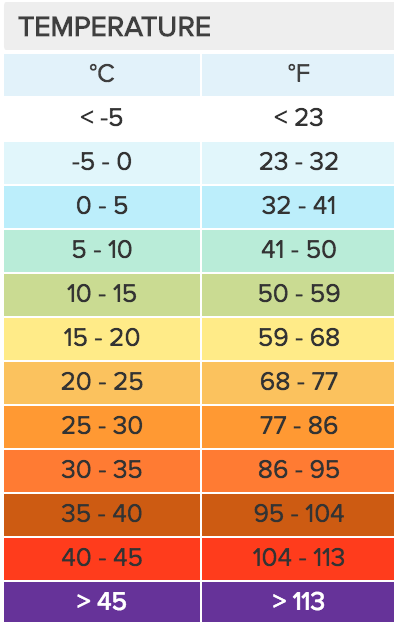Forecast
Launceston (41.4403°S, 147.1394°E, 13m AMSL) set as my default location ›
-
My MLA
-
Current condition
TODAY9° 21° mostly cloudy Chance of rain: 20% Likely amount: < 1mm First
light

Last light Sunrise Sunset 6:14am EST 6:42am EST 5:40pm EST 6:08pm EST NOW12.6° Feels Like: 12.2° Relative Humidity: 75% Dew: 8.4° Wind: N 0km/h Gust: 0km/h Rainfall since 9am: 0.0mm Pressure: -
Today Weather
LauncestonNow10.9°cFeels Like:8.4°Wind:NE 9km/hGusts:9km/hHumidity:77%9°Min21°MaxToday in LauncestonCloudy. Medium chance of showers, most likely in the morning and afternoon. Light winds becoming NW/NE 15 to 20 km/h in the middle of the day then becoming light in the late afternoon. Overnight temperatures falling to between 7 and 12 with daytime temperatures reaching around 19.Tomorrow8°Min24°MaxThe chance of fog in the early morning. Mostly sunny day. Slight chance of a shower, most likely at night. Light winds becoming N/NW 15 to 20 km/h in the late afternoon then becoming light in the evening. Overnight temperatures falling to between 6 and 11 with daytime temperatures reaching the low 20s. -
Radar
-
Popup Radar
-
Warnings
There are no current warnings for Launceston
-
7 day forecast
Today: Cloudy. Medium chance of showers, most likely in the morning and afternoon. Light winds becoming NW/NE 15 to 20 km/h in the middle of the day then becoming light in the late afternoon. Overnight temperatures falling to between 7 and 12 with daytime temperatures reaching around 19.
Forecast for Launceston (41.4403°S, 147.1394°E, 13m AMSL) Wed Thu Fri Sat Sun Mon Tue Summary Minimum 9° 8° 12° 12° 11° 10° 9° Maximum 21° 24° 23° 22° 21° 23° 22° Chance of rain 20% 60% 40% 80% 70% 50% 50% Likely amount < 1mm 1-5mm < 1mm 5-10mm 1-5mm < 1mm < 1mm UV index Moderate Moderate Moderate Moderate Moderate Moderate Moderate Fire Danger Rating Moderate Moderate Moderate Moderate - - - Frost risk Nil Nil Nil Nil Nil Nil Nil 9am 3pm 9am 3pm 9am 3pm 9am 3pm 9am 3pm 9am 3pm 9am 3pm Wind speed 5
(km/h)14
(km/h)3
(km/h)16
(km/h)6
(km/h)17
(km/h)8
(km/h)12
(km/h)10
(km/h)14
(km/h)7
(km/h)14
(km/h)5
(km/h)13
(km/h)Wind direction NE N SSW N NNE N N N NNW W SSE S SW WNW Relative humidity 69% 58% 76% 55% 83% 60% 82% 58% 81% 63% 76% 54% 76% 54% Dew point 10°C 11°C 11°C 14°C 15°C 14°C 14°C 13°C 13°C 13°C 12°C 13°C 11°C 11°C -
28 Day Rainfall forecast
-
12 Month Rainfall Forecast
Launceston Rain Forecast
Launceston 12-month Rainfall ForecastAprMayJunJulAugSepOctNovDecJanFebMar20252026656576566737105012 - 34 - 78 - 910Well below normalBelow normalNear normalAbove normalWell above normalIssue Notes - Issued Mar 28
ENSO status: Weak La Niña-like conditions. IOD status: Neutral. SAM status: Neutral. The El Niño Southern Oscillation (ENSO) is in a weak La Niña-like pattern. The US declared a La Niña event this summer, but this event has not met the BoM definition, and will likely end in the coming weeks. A La Niña typically increases rainfall over northern and eastern Australia, while reducing rainfall over southern coastal Australia and western Tas. The Indian Ocean Dipole (IOD) is in a neutral phase and does not play a part in Australia's climate during this time of year. The Southern Annular Mode (SAM) is in a neutral phase. Forecasts show a tendency towards the positive phase in autumn, with the long-wave pattern indicating that cold fronts are a bit less likely for Australia's longitudes over the next few months. During autumn, a positive SAM increases rainfall over most of eastern Australia, and decreases rainfall for SA, Vic and western Tas. Rainfall outlooks are showing above average rainfall across much of northern Australia in April due to lingering monsoon activity. Above average rainfall is expected for the NSW coast through autumn, with wetter conditions also developing over western WA from late autumn. SA, Vic and Tas are expected to be average to slightly below average, with average conditions elsewhere.
-
Popup - Daily historical
-
Long range rainfall forecast
-
Past 5 Days
Launceston Past 5 Days
This MonthMinimum Maximum Rainfall Friday
Apr 1110.2 °C 24.3 °C -Saturday
Apr 127.8 °C 22.2 °C -Sunday
Apr 1311.5 °C 24.7 °C 0.0 mmMonday
Apr 1412.2 °C - 5.2 mmTuesday
Apr 153.7 °C 20.2 °C -Legend -
Almanac
Almanac
Launceston minimum temp history (41.4403°S, 147.1394°E, 13m AMSL) MAXIMUM TEMPERATURE MINIMUM TEMPERATURE Hottest this month 24.7° 13/04/2025 Coldest this month 2.6° 08/04/2025 Hottest on record 27.7 12/04/1985 Coldest on record -1.5 26/04/1981 Hottest this year 33.5° 10/03/2025 Coldest this year 2.6° 08/04/2025 Long term average 19.1° Long term average 7.7° Average this month 20.8° Average this month 8.3° Hottest April On Record Avg. max. temp. 20.8° 1988 Coldest April on record Avg. min. temp. 5.0° 2006 Launceston rainfall history (41.4403°S, 147.1394°E, 13m AMSL) RAINFALL Wettest This Month 5.2mm 14/04/2025 Total This Month 5.6mm
2.0 daysLong Term Average 51.4mm 9.1 days Wettest April on record 124.6mm 1992 Driest on record 4.3mm 2007 -
Year to Date
Launceston Year To Date
Average Rainfall To Apr 167.6mm 29.1 day(s) Total For 2025 52.2mm 13.0 day(s) Total To This Day 2024 113.8mm 19.0 day(s) Wettest Day 12.6mm Mar13 Lowest Temperature 2.6°C Apr 8 Highest Temperature 33.5°C Mar10 -
Popup - Radar
Weather Radar for Australia
Australia Radars
- Adelaide
- Adelaide Airport
- Adelaide Sellicks
- Albany
- Alice Springs
- Bairnsdale
- Bowen
- Brewarrina
- Brisbane
- Brisbane Airport
- Brisbane Marburg
- Broadmeadows
- Broome
- Cairns
- Cairns Airport
- Canberra
- Carnarvon
- Ceduna
- Coffs Harbour
- Dampier
- Darwin
- Darwin Airport
- Emerald
- Esperance
- Eucla
- Geraldton
- Giles
- Gladstone
-
Popup - Monthly historical
-
Climatology
Climate History
Launceston Climatology
Launceston Long-Term Averages
Long-Term Averages Jan Feb Mar Apr May Jun Jul Aug Sep Oct Nov Dec Ann Mean Max (°C) 24.7 24.7 22.8 19.1 15.9 13.2 12.7 13.9 15.8 18.1 20.7 22.7 18.7 Mean Min (°C) 12.5 12.3 10.4 7.7 5.1 2.9 2.4 3.7 5.3 7.1 9.2 10.9 7.4 Mean Rain (mm) 44.5 30.8 40.9 51.4 62.7 68.9 79.3 83.5 63.5 53.0 51.6 48.0 679.1 Mean Rain Days 7.1 6.1 6.8 9.1 12.2 13.9 16.1 16.4 14.1 11.3 9.8 8.4 131.2



